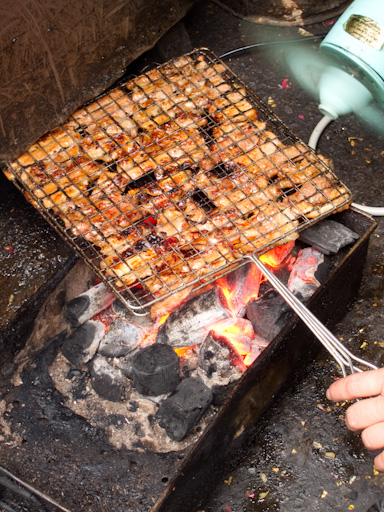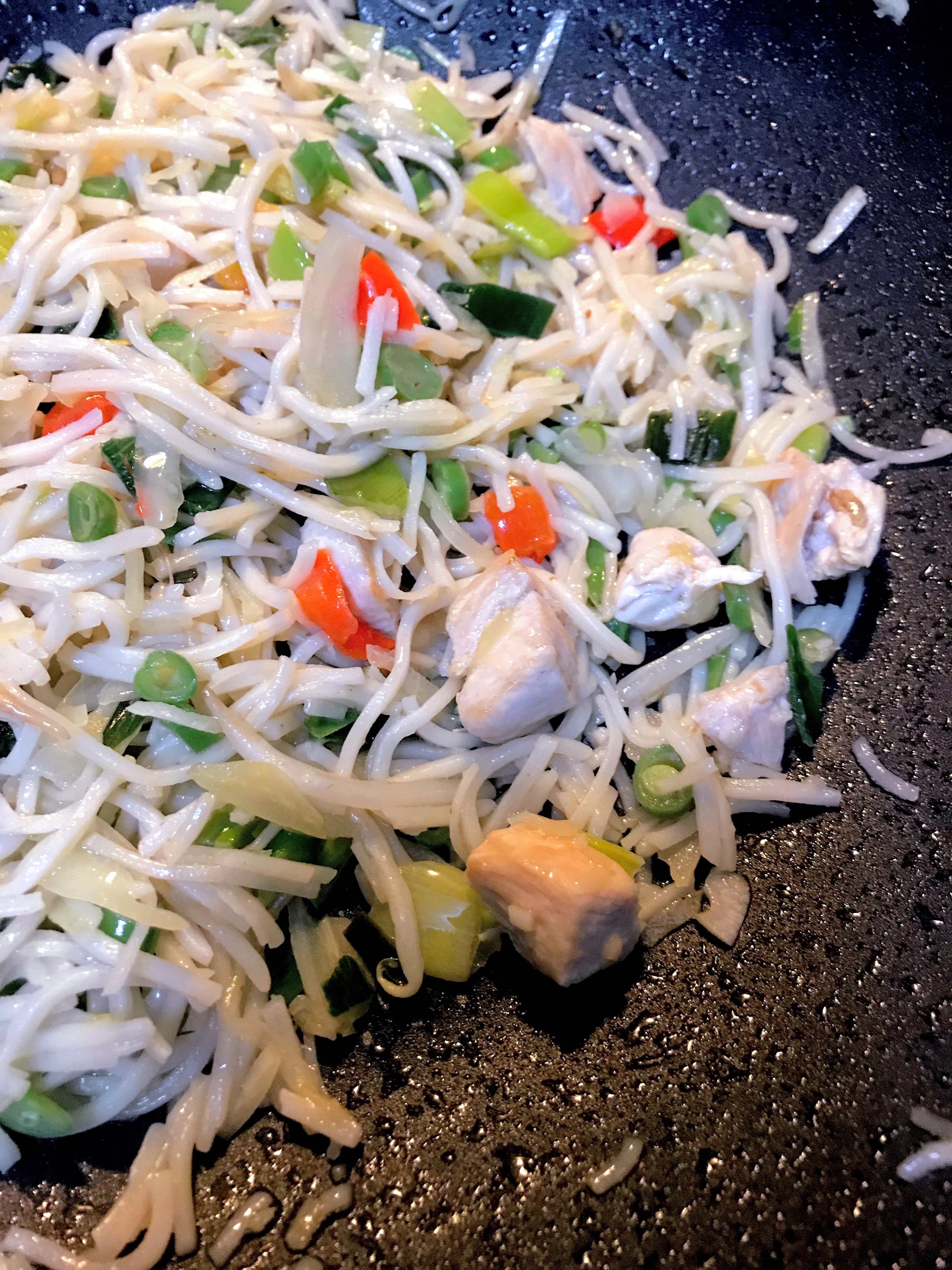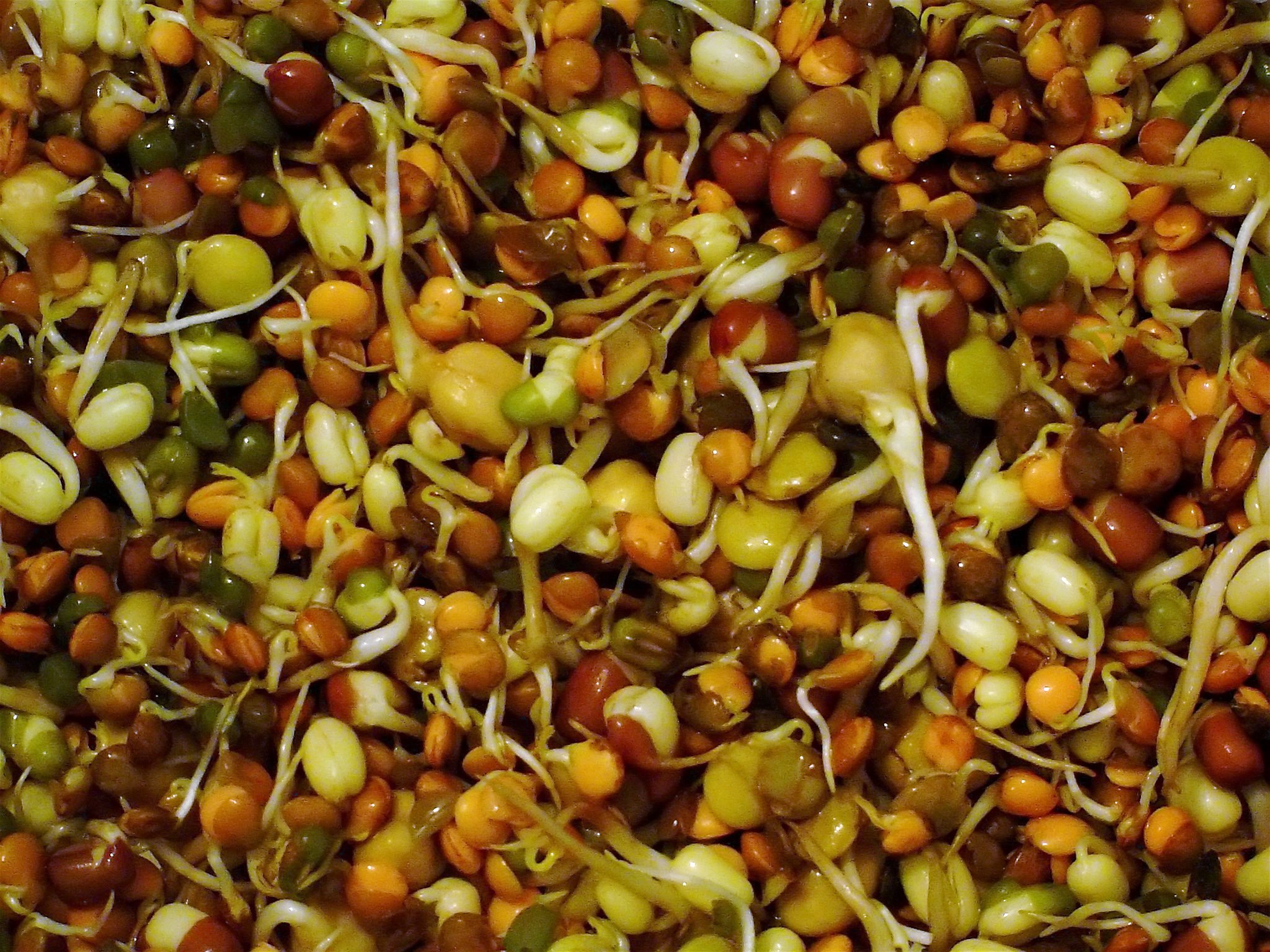|
Bún Chả
Bún chả () is a Vietnamese dish of grilled pork and noodle, which is thought to have originated from Hanoi, Vietnam. Bún chả is served with grilled fatty pork ('' chả'') over a plate of white rice noodle ('' bún'') and herbs with a side dish of dipping sauce. The dish was described in 1959 by Vietnamese food writer Vu Bang (1913–1984), who described Hanoi as a town "transfixed by bún chả." Hanoi's first bún chả restaurant was on Gia Ngư, Hoàn Kiếm District, in Hanoi's Old Quarter. Bún chả originated and remains very popular in Hanoi and throughout Vietnam. A very similar dish of rice vermicelli and grilled meat was invented in Southern Vietnam, called bún thịt nướng, which uses skewered meat in place of the grilled porkballs. ''Bún Chả Hương Liên'' restaurant in Hanoi became famous after United States President Barack Obama dropped in for bún chả with Chef Anthony Bourdain while he was on his trip to Vietnam in May 2016. Ingredients ... [...More Info...] [...Related Items...] OR: [Wikipedia] [Google] [Baidu] |
Vietnam
Vietnam or Viet Nam ( vi, Việt Nam, ), officially the Socialist Republic of Vietnam,., group="n" is a country in Southeast Asia, at the eastern edge of mainland Southeast Asia, with an area of and population of 96 million, making it the world's sixteenth-most populous country. Vietnam borders China to the north, and Laos and Cambodia to the west. It shares maritime borders with Thailand through the Gulf of Thailand, and the Philippines, Indonesia, and Malaysia through the South China Sea. Its capital is Hanoi and its largest city is Ho Chi Minh City (commonly known as Saigon). Vietnam was inhabited by the Paleolithic age, with states established in the first millennium BC on the Red River Delta in modern-day northern Vietnam. The Han dynasty annexed Northern and Central Vietnam under Chinese rule from 111 BC, until the first dynasty emerged in 939. Successive monarchical dynasties absorbed Chinese influences through Confucianism and Buddhism, and expanded ... [...More Info...] [...Related Items...] OR: [Wikipedia] [Google] [Baidu] |
Monosodium Glutamate
Monosodium glutamate (MSG), also known as sodium glutamate, is the sodium salt of glutamic acid. MSG is found naturally in some foods including tomatoes and cheese in this glutamic acid form. MSG is used in cooking as a flavor enhancer with an umami taste that intensifies the meaty, savory flavor of food, as naturally occurring glutamate does in foods such as stews and meat soups. MSG was first prepared in 1908 by Japanese biochemist Kikunae Ikeda, who was trying to isolate and duplicate the savory taste of ''kombu'', an edible seaweed used as a base for many Japanese soups. MSG balances, blends, and rounds the perception of other tastes. MSG is commonly used and found in stock (bouillon) cubes, soups, ramen, gravy, stews, condiments, savory snacks, etc. The U.S. Food and Drug Administration has given MSG its generally recognized as safe (GRAS) designation. It is a popular belief that MSG can cause headaches and other feelings of discomfort, known as "Chinese resta ... [...More Info...] [...Related Items...] OR: [Wikipedia] [Google] [Baidu] |
Vietnamese Noodle Dishes
Vietnamese may refer to: * Something of, from, or related to Vietnam, a country in Southeast Asia ** A citizen of Vietnam. See Demographics of Vietnam. * Vietnamese people, or Kinh people, a Southeast Asian ethnic group native to Vietnam ** Overseas Vietnamese, Vietnamese people living outside Vietnam within a diaspora * Vietnamese language * Vietnamese alphabet * Vietnamese cuisine * Vietnamese culture See also * List of Vietnamese people A ''list'' is any set of items in a row. List or lists may also refer to: People * List (surname) Organizations * List College, an undergraduate division of the Jewish Theological Seminary of America * SC Germania List, German rugby union ... * {{disambiguation Language and nationality disambiguation pages ... [...More Info...] [...Related Items...] OR: [Wikipedia] [Google] [Baidu] |
Vietnamese Words And Phrases
Vietnamese may refer to: * Something of, from, or related to Vietnam, a country in Southeast Asia ** A citizen of Vietnam. See Demographics of Vietnam. * Vietnamese people, or Kinh people, a Southeast Asian ethnic group native to Vietnam ** Overseas Vietnamese, Vietnamese people living outside Vietnam within a diaspora * Vietnamese language * Vietnamese alphabet * Vietnamese cuisine * Vietnamese culture See also * List of Vietnamese people A ''list'' is any set of items in a row. List or lists may also refer to: People * List (surname) Organizations * List College, an undergraduate division of the Jewish Theological Seminary of America * SC Germania List, German rugby unio ... * {{disambiguation Language and nationality disambiguation pages ... [...More Info...] [...Related Items...] OR: [Wikipedia] [Google] [Baidu] |
Rice Noodles
Rice noodles, or simply rice noodle, are noodles made with rice flour and water as the principal ingredients. Sometimes ingredients such as tapioca or corn starch are added in order to improve the transparency or increase the gelatinous and chewy texture of the noodles. Rice noodles are most common in the cuisines of East and Southeast Asia. They are available fresh, frozen, or dried, in various shapes, thicknesses and textures. Fresh noodles are also highly perishable; their shelf life may be just several days. History The origin of rice noodles dates back to China during the Qin dynasty when people from northern China invaded the south. Due to climatic conditions, the northern Chinese have traditionally preferred wheat and millet which grew in cold weather while the southern Chinese preferred rice which grew in hot weather. Noodles are traditionally made out of wheat and eaten throughout northern China so to adapt, northern cooks tried to prepare "noodles" using rice, thus inv ... [...More Info...] [...Related Items...] OR: [Wikipedia] [Google] [Baidu] |
Bún Thịt Nướng
B, or b, is the second letter of the Latin-script alphabet, used in the modern English alphabet, the alphabets of other western European languages and others worldwide. Its name in English is '' bee'' (pronounced ), plural ''bees''. It represents the voiced bilabial stop in many languages, including English. In some other languages, it is used to represent other bilabial consonants. History Old English was originally written in runes, whose equivalent letter was beorc , meaning "birch". Beorc dates to at least the 2nd-century Elder Futhark, which is now thought to have derived from the Old Italic alphabets' either directly or via Latin . The uncial and half-uncial introduced by the Gregorian and Irish missions gradually developed into the Insular scripts' . These Old English Latin alphabets supplanted the earlier runes, whose use was fully banned under King Canute in the early 11th century. The Norman Conquest popularised the Carolingian half-uncial forms which ... [...More Info...] [...Related Items...] OR: [Wikipedia] [Google] [Baidu] |
Bún Chả Hàng Mành
Rice vermicelli is a thin form of noodle. It is sometimes referred to as 'rice noodles' or 'rice sticks', but should not be confused with cellophane noodles, a different Asian type of vermicelli made from mung bean starch or rice starch rather than rice grains themselves. Presentation and varieties Rice vermicelli is a part of several Asian cuisines, where it are often eaten as part of a soup dish, stir-fry, or salad. One particularly well-known, slightly thicker variety, called ''Guilin mǐfěn'' (桂林米粉), comes from the southern Chinese city of Guilin, where it is a breakfast staple. Names Rice vermicelli is widely known in Asia by cognates of Hokkien 米粉 (''bí-hún'', literally "rice vermicelli"). These include ''bīfun'' (Japan), ''bíjon'' or ''bihon'' (Philippines), ''bee hoon'' (Singapore), ''bihun'' or ''mee hoon'' (Malaysia and Indonesia), ''num banh chok'' (Cambodia), ''bún'' (Vietnam), and ''mee hoon'' (Southern Thailand). Naming in Taiwan Beginning Ju ... [...More Info...] [...Related Items...] OR: [Wikipedia] [Google] [Baidu] |
Elsholtzia Ciliata
''Elsholtzia ciliata'', commonly known as Vietnamese balm, xiang ru (香薷) or ''kinh giới'' in Vietnamese, is a plant native to Asia. In the US, it can go by the name Crested Late Summer Mint. In US Vietnamese grocery stores, it is called Kinh Gioi, Vietnamese Lemon Balm, or Vietnamese Lemon Mint. Distribution The plant is native to Asia. However, the exact extent of its original range is unclear. Today it is found through much of India, eastern Asia, and Europe. It grows throughout Nepal at elevations of 1500 to 3400 m. Description ''Elsholtzia ciliata'' is an erect herb that grows to about 60 cm in height. The leaves are long, stalked, and serrated, and reach 2 to 8.5 cm in length and 8 to 2.5 cm in width. In shape, they are ovate to lanceolate, with a gland-dotted underside. Flowers of a purple color bloom in flat spikes in September and October. Seeds propagate within them. Uses ''Elsholtzia ciliata'' has many cultural uses. Culinary It is us ... [...More Info...] [...Related Items...] OR: [Wikipedia] [Google] [Baidu] |
Beansprout
Sprouting is the natural process by which seeds or spores germinate and put out shoots, and already established plants produce new leaves or buds, or other structures experience further growth. In the field of nutrition, the term signifies the practice of germinating seeds (for example, mung beans or sunflower seeds) to be eaten raw or cooked, which is considered more nutritious. Suitable seeds All viable seeds can be sprouted, but some sprouts, such as kidney beans, should not be eaten raw. Bean sprouts are a common ingredient across the world. They are particularly common in Eastern Asian cuisine. It typically takes one week for them to become fully grown. The sprouted beans are more nutritious than the original beans, and they require much less cooking time. There are two common types of bean sprouts: * Mung bean sprouts, made from greenish-capped mung beans * Soybean sprouts, made from yellow, large-grained soybeans Common sprouts used as food include: * Pulses ... [...More Info...] [...Related Items...] OR: [Wikipedia] [Google] [Baidu] |
Limnophila Aromatica
''Limnophila aromatica'', the rice paddy herb, is a tropical flowering plant in the family Plantaginaceae. It is native to Southeast Asia, where it flourishes in hot temperatures and grows most often in watery environments, particularly in flooded rice fields. It is called or or in Vietnam and used as an herb and also cultivated for use as an aquarium plant. The plant was introduced to North America in the 1970s due to Vietnamese immigration following the Vietnam War. It is called "ma om" (ម្អម) in Khmer. It is used in traditional Cambodian soup dishes and Southern Vietnamese cuisine. It can grow in flooded rice paddies during wet season but it grows best on drained but still wet sandy soil of harvested rice paddies for a few months after the rainy season ended. It dies out soon after it flowers. Rural Cambodians often harvest them and put them on the roof of their houses to dry for later use. Taxonomy ''Limnophila aromatica'' was formerly classified as a memb ... [...More Info...] [...Related Items...] OR: [Wikipedia] [Google] [Baidu] |
Basil
Basil (, ; ''Ocimum basilicum'' , also called great basil, is a culinary herb of the family Lamiaceae (mints). It is a tender plant, and is used in cuisines worldwide. In Western cuisine, the generic term "basil" refers to the variety also known as sweet basil or Genovese basil. Basil is native to tropical regions from Central Africa to Southeast Asia. In temperate climates basil is treated as an annual plant, however, basil can be grown as a short-lived perennial or biennial in warmer horticultural zones with tropical or Mediterranean climates. There are many varieties of basil including sweet basil, Thai basil (''O. basilicum'' var. ''thyrsiflora''), and Mrs. Burns' Lemon (''O. basilicum var. citriodora''). ''O. basilicum'' can cross-pollinate with other species of the ''Ocimum'' genus, producing hybrids such as lemon basil (''O. × citriodorum'') and African blue basil (''O. × kilimandscharicum''). Etymology The name "basil" comes from the Latin , and the Greek (), m ... [...More Info...] [...Related Items...] OR: [Wikipedia] [Google] [Baidu] |
Kohlrabi
Kohlrabi (pronounced ; scientific name ''Brassica oleracea'' Gongylodes Group), also called German turnip or turnip cabbage, is a biennial vegetable, a low, stout cultivar of wild cabbage. It is a cultivar of the same species as cabbage, broccoli, cauliflower, kale, Brussels sprouts, collard greens, Savoy cabbage, and gai lan. It can be eaten raw or cooked. Edible preparations are made with both the stem and the leaves. Despite its common names, it is not the same species as turnip, although both are in the genus ''Brassica''. Etymology The name comes from the German ''Kohl'' ("cabbage") plus ''Rübe'' ~ ''Rabi'' (Swiss German variant) ("turnip"), because the swollen stem resembles the latter. Its Group name Gongylodes (or lowercase and italicized ''gongylodes'' or ''gongyloides'' as a variety name) means "roundish" in Greek, from (, ‘round’). In Iran, it is called 'Kalam Qomi' or 'Kalam Qomri' (کلم قمری) and is used for various dishes, including a type of soup. ... [...More Info...] [...Related Items...] OR: [Wikipedia] [Google] [Baidu] |




